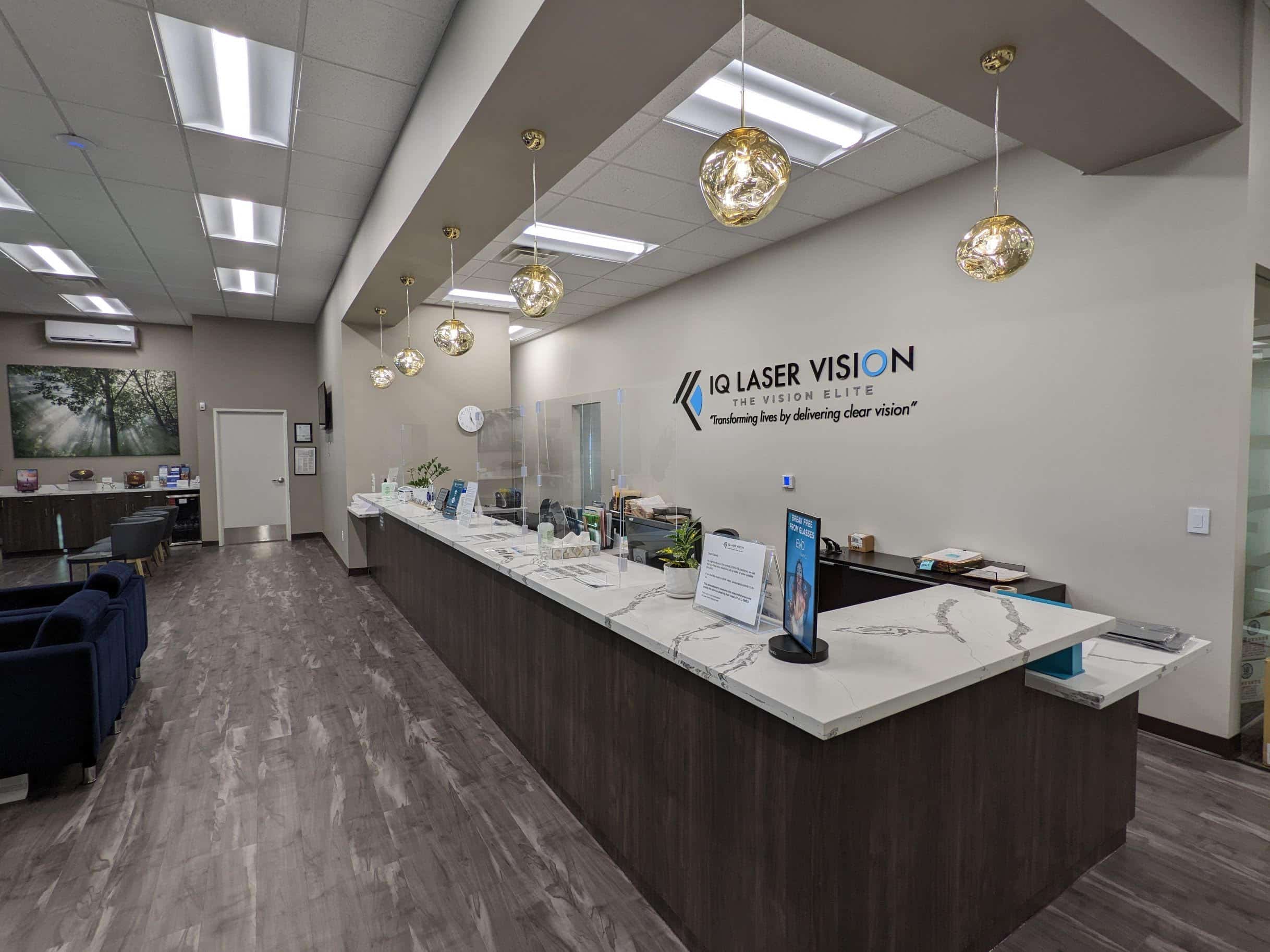Eye infections are serious business. And that’s why we do everything we can to treat them quickly—and help prevent them in the first place. But would you know what an eye infection was if you had one? Or the simple steps you can take to prevent them happening to you? Consider this your quick guide to eye infections. And learn how to prevent eye infections!
First off, eye infections are unfortunately pretty common (but that doesn’t mean they can’t be dangerous). Of the many eye infections that happen each year, about a million eye infections require a visit to the doctor or hospital. And many of these eye infections can be traced back to contact lenses. (There’s a reason we aren’t proponents of contacts and believe that refractive eye surgeries are the best solution for vision correction. Now you know.)
So without further adieu, let’s jump into the nitty-gritty of eye infections and make sure you’re properly prepared to avoid them and treat them, especially with cold and flu season around the corner.
What is an eye infection?
Eye infections can be caused by bacteria, viruses, acanthamoeba or fungi. Eye infection is a blanket term that covers a number of eye ailments, including keratitis, blepharitis, conjunctivitis (commonly called ‘pink eye’) and other conditions. And while some conditions, uncomfortable though they might be, can clear up on their own, some of the most serious eye infections can threaten your vision if not treated immediately. Corneal ulcers, Endophthalmitis and orbital cellulitis are a few of these dangerous conditions (but more on that later).
What does an eye infection feel like?
Eye infection symptoms can show up in a number of different areas in or around the eyes. You may experience symptoms on the eyelid, the cornea or the conjunctiva (that thin area on your inner eyelid). Some symptoms of eye infections include red, painful, burning eyes, blurred vision, sensitivity to light, watery eyes, discharge or pain in the eyes, swollen eyelids, and that nagging feeling that you’ve got something in your eye.
Infections can be pretty unpleasant. But when are they actually dangerous? Keep reading to find out.
Types of eye infections
- Viral eye infections are some of the most common eye infections experienced by adults. But just because they’re common doesn’t mean they’re not dangerous. Some viral infections, such as viral conjunctivitis, can be very uncomfortable (and extremely contagious) but can pass on their own. Other viral infections can leave long-lasting damage to your peepers. Viral eye infections may leave scars on the cornea, or even damage the retina permanently without prompt and proper treatment.
- Bacterial eye infectionsoccur when bacteria (like staph or strep) enters your eye. These can result in yellow or green discharge from the eyes, crusty eyes upon waking, swelling, itchiness and redness.
- Fungal eye infections tend to be more rare and typically occur after an injury, especially if the item that injured your eye is made from plants, like a thorn or twig, etc. They may also develop after certain invasive eye surgeries and can be very challenging to treat. Fungal infections in your bloodstream can also carry the infection to your eye.
- Acanthamoeba keratitis is caused by amoeba that are found naturally in water sources and usually cause infections in contact lens users. These corneal infections are hard to diagnose and treat and frequently cause permanent scarring and a need for corneal transplantation.
COMMON EYE INFECTIONS/INFLAMMATION
- Conjunctivitis (pink eye) is pretty common among kids, and among adults who work with kids. It’s typically caused by the same virus as the common cold. The highly contagious infection results in swollen, extremely itchy, pink eyes and eyelid swelling.
- Styes/Chalazia happen when an eyelash follicle is infected or a lid gland is clogged. These infections will generally go away on their own but can occasionally progress to more serious cellulitis.
- Blepharitis is a common inflammatory response of the eyelids to normal bacteria. It can cause eye redness, foreign body sensation and a decrease in vision. It is a chronic disease and needs to be treated with long-term preventative measures.
When eye infections turn dangerous
Eye infections may not be particularly dangerous in and of themselves, though they tend to be very uncomfortable. But even a simple infection left untreated can develop into more serious conditions that could affect your vision (and more!) for the long-term. Some dangerous conditions that may stem from untreated eye infections include:
- Corneal Scarring and perforation are pretty common with untreated eye infections. When the scarring occurs in the center of the eye they can permanently decrease your vision. At that point, surgical procedures will be needed to regain your vision. Rarely, an infection can even cause a hole in the cornea and require emergency intervention.
- Endophthalmitis is an infection inside the eye that can be caused by surgery or spread from the front of the eye or through the bloodstream. This is extremely dangerous and frequently results in permanent vision loss.
- Orbital cellulitis is a dangerous infection that may begin as a sinus infection or from the introduction of staph or strep bacteria into the orbital region. Symptoms include high fevers, pain when moving the eye, feeling ill, double vision, shiny, red or purple eyelids, bulging eyes and poor vision. Your upper and lower eyelids may be painfully swollen. Complications of this condition could result in everything from hearing loss, blood infections and meningitis to optic nerve damage (leading to vision loss) and even death. Seek immediate treatment if you suspect this dangerous condition.
What to do if you suspect an eye infection?
While some types of bacterial or viral eye infections resolve on their own, they can be pretty uncomfortable while you wait for that to happen. Because your eyesight and health are important, you should never leave them to chance. If you think you have an eye infection, or exhibit any of the symptoms above, it’s vital to get your eyes checked out by your ophthalmologist. Symptoms of simple infections can often be the same as symptoms of the beginning of a very serious infection.
Without the proper tools and knowledge to diagnose a condition (and the microorganism that might be affecting your eye), you may mistakenly think the infection will just go away on its own. Your eye doctor can not only diagnose and treat your eye infection but can also uncover any underlying issues or triggers that could be further exacerbating your eyes. Ask your Dr if there’s anyway to prevent eye infections.
Your eye doctor can prescribe medications that will reduce eye infection discomfort and target the specific microorganism to stop it dead in its tracks.
Okay, so know that you know a bit more about eye infections, you’re probably wondering what contact lenses have to do with them. Read on.
The contact connection
Once upon a time, contact lenses were viewed as a more attractive option than glasses. And when looking good and living glasses-free makes the top of your list, it might still seem that way. It’s why about 38 million Americans wear contact lenses today. But research has shown that contact lenses can pose some pretty serious risks to your vision (and the environment too!). Yep. In fact, the CDC reported that 20% of all eye infections that stem from contact lenses cause serious damage to the eyes.
About 80-90% of contact lens-related eye infections are bacterial infections, and the most serious type, known as pseudomonas aeruginosa, can actually create a hole in your cornea. Trust us when we say that’s bad news for your vision. This type of eye infection can sometimes be irreversible, resulting in scarred eye tissue and lost vision.
Prime causes of contact lens-related eye Issues
- Sleeping in contact lenses
Sleeping in contacts not only leads to discomfort and irritation but can also result in a pretty serious infection known as microbial keratitis. One study showed that sleeping in contacts was a likely prime culprit for this infection.
- Swimming or showering with contact lenses
Water naturally contains a number of microorganisms and impurities. Under normal conditions, they might not be a problem. However, a contact lens study found that a microorganism called Acanthamoeba (which causes eye pain and can even lead to blindness) was attracted to the bacteria that live on contact lenses.
- Washing your contact lenses in tap water
The same Acanthamoeba present in pools and showers will quickly gather on your contacts when you soak them in regular water. If you want to avoid corneal inflammation and scarring, avoid using tap water to rinse or soak your contacts.
- Wearing old contact lenses
Once contact lenses pass their expiration date, they are often full of germs and contaminants that should never go near your eyes. Not only will they be more uncomfortable than they were before, but wearing old contact lenses can lead to eye infections and damage.
All that, and we haven’t even touched the fact that contact lenses can scratch the surface of the eye, making it more prone to infections.
With so much potential for damage, we have to ask, is it worth it? We’d wager it’s just not.
How to prevent eye infections
Preventing eye infections, in many cases, simply takes some common sense. Here’s our quick list of some practical things you can do today to help prevent eye infections.
- Wash your hands whenever you venture into public areas, and also at home.
- Avoid rubbing and touching your eyes.
- Isolate any communicable conditions like pinkeye.
- Always take your contacts out before sleeping
- Store and disinfect contact lenses in the proper solution
- Practice safe contact lens use (or get rid of them altogether)
Prevention is key. And getting rid of your contact lenses for good can help minimize the risk of developing a serious eye infection. Book a free consultation today with our world-class team of ophthalmologists, or give us a call at (888) 539-2211. We can help you find the right solution for your eyes to keep your vision healthy and strong long into the future.























